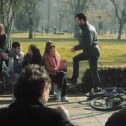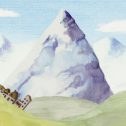"Apparently, rocks are having conversations all around us, but they talk very, very slowly..."
Das Rad is a short film about two rock characters who witness the evolution of human civilization and its impact on the environment. It was created by Chris Stenner, Arvid Uibel and Heidi Wittlinger during their studies at the Filmakademie Baden-Württemberg. The short presents two main characters, an environmentalist message and a focus on passage of time, with playful use of changes of pace.
Staged in a rural area that transforms into a location filled with high-rise buildings, Das Rad offers a critical look at the evolution of human civilization and its development. The story is told mainly from the point of view of two rock characters, who act as spectators and may be interpreted as representing the point of view of nature itself.
The authors came up with an interesting narrative device, which is to speed up time, and portray the POV of the rocks as taking place much slower than that of humans, with changes taking place around them in the landscape at a faster pace (in essence, staging the film with time running at different speeds in the same space). This helps show humans’ short lifespans, as well as the impact their technology is having on the planet. The POV of humans is represented in “real-time”, at standard pace. There are points of contact between the two narrative POVs, which are key to advancing the story. Spatial and temporal continuity are maintained. Changes in pace are implemented that make the film switch between the different POVs – which introduces an element of surprise, adding humor and unexpected turns to the story.
There’s a lot of effort dedicated to animation due to using a stop-motion technique, the amount of work done on the environment itself is impressive. Due to this, many very wide shots are used, in combination with two-shots and full shots and some close-ups. The lack of expressiveness of the characters (rocks’ body language is not that flexible) is complemented through the voices.
Other highlights of the short include the way the environment is used to depict the advance of “civilization” (including the change in color to grey), the sequence of the stroboscopic ad and the reaction shot of the rock characters, the way a moving camera is used to personify “civilization” and how it approaches the characters to build conflict, and the authors’ choice of leaving the final plot point unexplained.



















Recent Comments